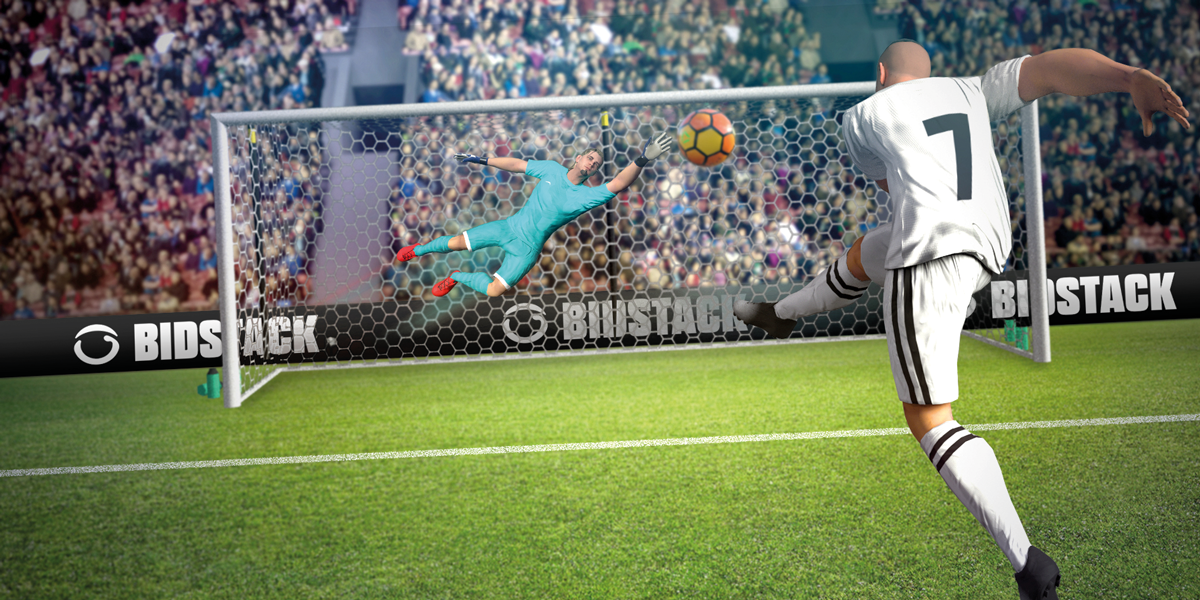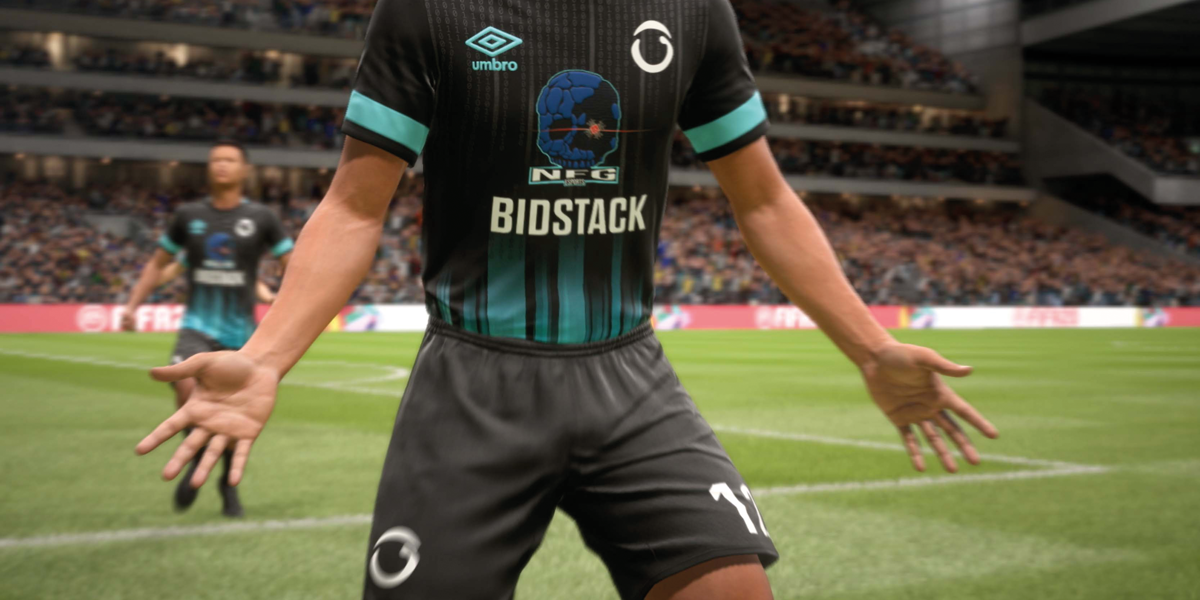In-game advertising with Bidstack

Posted on Aug 3, 2022 by FEED Staff
Targeted advertising is being deployed by brands in the video games space. But are consumers ready for adtech?
Words by Michael Burns
Digital advertising agencies have been putting in a concentrated effort to exploit the time audiences spend on gaming, taking particular aim at the valuable, yet elusive Gen Z.
“There is a trend of companies diving into the industry to claim their piece of the gaming pie, seen at the recent CES,” says Maxym Dmytriyev, gaming analyst at Futuresource Consulting. “This is a new revenue stream to tap into, and even the likes of Amazon and Google – whose revenues are built upon direct and indirect advertising – have entered the market, with ambitious cloud-gaming solutions.”
In-game advertising (IGA) is not a new concept.
“It has existed for years, in the form of static product placements and licensing of brands within sports games, either as stand-alone ads or interactive objects (ie car brands in racing games),” says Dmytriyev. “Dynamic personalised ads, on the other hand, are a nascent technology, which has a better chance for success with subscription gaming – in part due to the potential for user tracking, but also by removing gamers’ rights to complain about adverts in a fully paid game. Advertising promises a new and incremental revenue stream. It’s on the rise, but relatively small compared to other revenues from gaming software, hardware and peripherals.”
In practice, IGA follows similar principles to digital out-of-home (DOOH) media, making use of the advertising technology and practices that have been built up around it – creating more than the one-ad-fits-all techniques of the past. Agencies working with game publishers allow advertisers and brands to place dynamic advertisements inside video games, most commonly using banners, billboards or trackside hoardings – reflecting real-world usage.
“Traditional-format advertising can be executed particularly well in sports games such as FIFA,
MLB, NBA, Dirt Rally, Forza and so on,” says Dmytriyev. “Players are no strangers to ads in
real sports events, so it’s a natural fit. In fact, it’s used to enhance the environment, making it feel more authentic.”
Open-world games with cityscapes can deliver billboards, branded vehicles, buildings and other surfaces for virtual ads. ‘Native’ placements that don’t disrupt the gaming experience are the key.
“Successful brands within in-game environments are those that don’t elbow their way to the fore, but respect the importance of in-game interactions that are appropriate to the context,” says Niklas Bakos, founder and CSO of in-game platform Adverty, on the IAB UK website. “Research tells us that unobtrusive formats are often more effective than disruptive ones, and ads that reach out of the gameplay have a unique opportunity to enhance human connection, and even fuel creativity.”
Indeed, the market for such native advertising is worth an estimated $25bn, according to in-game advertising platform Anzu.
Targeted advertising is being deployed by brands in the video games space. But are consumers ready for adtech?
Words by Michael Burns
Digital advertising agencies have been putting in a concentrated effort to exploit the time audiences spend on gaming, taking particular aim at the valuable, yet elusive Gen Z.
“There is a trend of companies diving into the industry to claim their piece of the gaming pie, seen at the recent CES,” says Maxym Dmytriyev, gaming analyst at Futuresource Consulting. “This is a new revenue stream to tap into, and even the likes of Amazon and Google – whose revenues are built upon direct and indirect advertising – have entered the market, with ambitious cloud-gaming solutions.”
In-game advertising (IGA) is not a new concept.
“It has existed for years, in the form of static product placements and licensing of brands within sports games, either as stand-alone ads or interactive objects (ie car brands in racing games),” says Dmytriyev. “Dynamic personalised ads, on the other hand, are a nascent technology, which has a better chance for success with subscription gaming – in part due to the potential for user tracking, but also by removing gamers’ rights to complain about adverts in a fully paid game. Advertising promises a new and incremental revenue stream. It’s on the rise, but relatively small compared to other revenues from gaming software, hardware and peripherals.”
In practice, IGA follows similar principles to digital out-of-home (DOOH) media, making use of the advertising technology and practices that have been built up around it – creating more than the one-ad-fits-all techniques of the past. Agencies working with game publishers allow advertisers and brands to place dynamic advertisements inside video games, most commonly using banners, billboards or trackside hoardings – reflecting real-world usage.
“Traditional-format advertising can be executed particularly well in sports games such as FIFA,
MLB, NBA, Dirt Rally, Forza and so on,” says Dmytriyev. “Players are no strangers to ads in
real sports events, so it’s a natural fit. In fact, it’s used to enhance the environment, making it feel more authentic.”
Open-world games with cityscapes can deliver billboards, branded vehicles, buildings and other surfaces for virtual ads. ‘Native’ placements that don’t disrupt the gaming experience are the key.
“Successful brands within in-game environments are those that don’t elbow their way to the fore, but respect the importance of in-game interactions that are appropriate to the context,” says Niklas Bakos, founder and CSO of in-game platform Adverty, on the IAB UK website. “Research tells us that unobtrusive formats are often more effective than disruptive ones, and ads that reach out of the gameplay have a unique opportunity to enhance human connection, and even fuel creativity.”
Indeed, the market for such native advertising is worth an estimated $25bn, according to in-game advertising platform Anzu.


Bidding to win
Technology company Bidstack offers a bespoke service for brands to place ads across a variety of games. According to Yasin Dabhelia, Bidstack’s head of automation and demand partnerships, “Our tech is built around programmatic delivery of advertising into the gaming environment. We support any sort of game, whether that be mobile, PC console, VR or AR. The ad looks and fits within the context of the game – and we’re not interrupting the gameplay.”
Bidstack was founded in 2015 by CEO James Draper, who came from an out-of-home advertising background and wanted to place it in a virtual space.
“At the time, no one really saw gaming as a serious media channel,” says Dabhelia. “Advertising within gaming was always thought of as being intrusive, like rewarded video, where you can’t move forward until you react or watch the ads. In the past two to three years, we’ve started to see games such as Fortnite, and the metaverse, really grow with all these new opportunities. And Covid-19 actually really helped propel the IGA industry forward.”
Dabhelia joined Bidstack in 2020, just as the UK went into lockdown. “That year was a massive education, telling people about the benefits of in-game advertising and getting their heads around the non-intrusiveness of it. By 2021, brands were beginning to invest in the space and recognise it as a serious media channel.”
Bidding to win
Technology company Bidstack offers a bespoke service for brands to place ads across a variety of games. According to Yasin Dabhelia, Bidstack’s head of automation and demand partnerships, “Our tech is built around programmatic delivery of advertising into the gaming environment. We support any sort of game, whether that be mobile, PC console, VR or AR. The ad looks and fits within the context of the game – and we’re not interrupting the gameplay.”
Bidstack was founded in 2015 by CEO James Draper, who came from an out-of-home advertising background and wanted to place it in a virtual space.
“At the time, no one really saw gaming as a serious media channel,” says Dabhelia. “Advertising within gaming was always thought of as being intrusive, like rewarded video, where you can’t move forward until you react or watch the ads. In the past two to three years, we’ve started to see games such as Fortnite, and the metaverse, really grow with all these new opportunities. And Covid-19 actually really helped propel the IGA industry forward.”
Dabhelia joined Bidstack in 2020, just as the UK went into lockdown. “That year was a massive education, telling people about the benefits of in-game advertising and getting their heads around the non-intrusiveness of it. By 2021, brands were beginning to invest in the space and recognise it as a serious media channel.”


Playing the game
Bidstack has a proprietary supply-side platform (SSP), that allows publishers to trade in-game ads programmatically, facilitating commercial agreements with agencies and brands. Using Bidstack’s AdConsole platform, advertisers and game developers can monitor campaign progress, manage creative approvals, analyse inventory and track key performance metrics.
“Sometimes an advertiser targets a game, just because they want their brand to be everywhere. But we get clients that say, ‘Can we just target females over 18?’ Or, if there is a company like Marriott, affiliated with Manchester United, they will ask for placement only inside Manchester United’s stadium in the game Football Manager,” says Dabhelia.
Creative approval is built into the ecosystem. “We are educating advertisers specifically on how to build formats for gaming. As soon as their ad comes to our platform, it won’t go live until it passes our process and the game publisher is happy. It could be that the ad doesn’t fit the context, or it’s an unwanted alcohol brand. Perhaps it doesn’t look right for the gaming environment, or creative specs haven’t been adhered to.
“We’re very much handholding during that process. We want to have a close relationship – everything is done on a deal, not an open marketplace – and we want to make sure it’s built in the right way.”
Bidstack is able to dynamically insert, change and target advertising, based on the audience playing the game. As soon as it has loaded, the targeted ad is delivered within seconds.
“We grab information from the SDK about the gaming environment, and all the elements happening in the game, so when the ad renders, it looks very natural,” Dabhelia explains. ”In a racing game, the ad will flap in the wind, or if it’s raining and you’re in a racing car, mud splashes against the ad and drips down; it looks real. No one else does that. We care about the authenticity and environment of the game, as well as the ad.”
Bidstack has started to branch into VR, too, working with sports technology company Rezzil on a football game that’s also being used as rehabilitative training for players.
“We’ve had access to that in terms of placing billboards in various different spaces within the training facilities, in the VR headsets that they are using,” he says. “We want to go a little bit further than that, and think about native and intrinsic value-add. How we can offer the advertising, so it actually gives some sort of value for the player.”
This article first featured in the Spring 2022 issue of FEED.
Gaming and Esports archives
Playing the game
Bidstack has a proprietary supply-side platform (SSP), that allows publishers to trade in-game ads programmatically, facilitating commercial agreements with agencies and brands. Using Bidstack’s AdConsole platform, advertisers and game developers can monitor campaign progress, manage creative approvals, analyse inventory and track key performance metrics.
“Sometimes an advertiser targets a game, just because they want their brand to be everywhere. But we get clients that say, ‘Can we just target females over 18?’ Or, if there is a company like Marriott, affiliated with Manchester United, they will ask for placement only inside Manchester United’s stadium in the game Football Manager,” says Dabhelia.
Creative approval is built into the ecosystem. “We are educating advertisers specifically on how to build formats for gaming. As soon as their ad comes to our platform, it won’t go live until it passes our process and the game publisher is happy. It could be that the ad doesn’t fit the context, or it’s an unwanted alcohol brand. Perhaps it doesn’t look right for the gaming environment, or creative specs haven’t been adhered to.
“We’re very much handholding during that process. We want to have a close relationship – everything is done on a deal, not an open marketplace – and we want to make sure it’s built in the right way.”
Bidstack is able to dynamically insert, change and target advertising, based on the audience playing the game. As soon as it has loaded, the targeted ad is delivered within seconds.
“We grab information from the SDK about the gaming environment, and all the elements happening in the game, so when the ad renders, it looks very natural,” Dabhelia explains. ”In a racing game, the ad will flap in the wind, or if it’s raining and you’re in a racing car, mud splashes against the ad and drips down; it looks real. No one else does that. We care about the authenticity and environment of the game, as well as the ad.”
Bidstack has started to branch into VR, too, working with sports technology company Rezzil on a football game that’s also being used as rehabilitative training for players.
“We’ve had access to that in terms of placing billboards in various different spaces within the training facilities, in the VR headsets that they are using,” he says. “We want to go a little bit further than that, and think about native and intrinsic value-add. How we can offer the advertising, so it actually gives some sort of value for the player.”
This article first featured in the Spring 2022 issue of FEED.
Gaming and Esports archives



